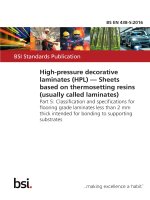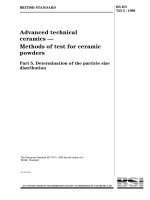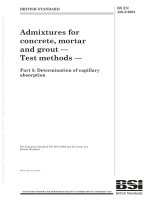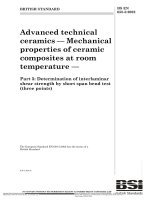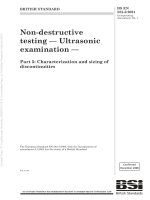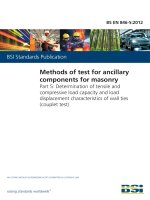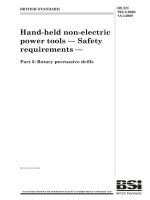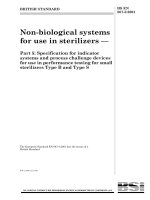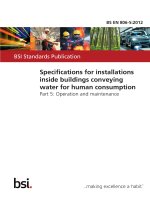Bsi bs en 61784 5 14 2013
Bạn đang xem bản rút gọn của tài liệu. Xem và tải ngay bản đầy đủ của tài liệu tại đây (1.59 MB, 36 trang )
BS EN 61784-5-14:2013
BSI Standards Publication
Industrial communication
networks — Profiles
Part 5-14: Installation of fieldbuses —
Installation profiles for CPF 14
BRITISH STANDARD
BS EN 61784-5-14:2013
National foreword
This British Standard is the UK implementation of EN 61784-5-14:2013. It is
identical to IEC 61784-5-14:2013. It supersedes BS EN 61784-5-14:2012
which is withdrawn.
The UK participation in its preparation was entrusted to Technical Committee AMT/7, Industrial communications: process measurement and
control, including fieldbus.
A list of organizations represented on this committee can be obtained on
request to its secretary.
This publication does not purport to include all the necessary provisions of
a contract. Users are responsible for its correct application.
© The British Standards Institution 2014.
Published by BSI Standards Limited 2014
ISBN 978 0 580 84200 9
ICS 25.040.40; 35.100.40
Compliance with a British Standard cannot confer immunity from
legal obligations.
This British Standard was published under the authority of the
Standards Policy and Strategy Committee on 31 January 2014.
Amendments/corrigenda issued since publication
Date
Text affected
BS EN 61784-5-14:2013
EN 61784-5-14
EUROPEAN STANDARD
NORME EUROPÉENNE
EUROPÄISCHE NORM
December 2013
ICS 25.040.40; 35.100.40
Supersedes EN 61784-5-14:2012
English version
Industrial communication networks Profiles Part 5-14: Installation of fieldbuses Installation profiles for CPF 14
(IEC 61784-5-14:2013)
Réseaux de communication industriels Profils Partie 5-14: Installation des bus de terrain Profils d'installation pour CPF 14
(CEI 61784-5-14:2013)
Industrielle Kommunikationsnetze Profile Teil 5-14: Feldbusinstallation Installationsprofile für die
Kommunikationsprofilfamilie 14
(IEC 61784-5-14:2013)
This European Standard was approved by CENELEC on 2013-10-18. CENELEC members are bound to comply
with the CEN/CENELEC Internal Regulations which stipulate the conditions for giving this European Standard
the status of a national standard without any alteration.
Up-to-date lists and bibliographical references concerning such national standards may be obtained on
application to the CEN-CENELEC Management Centre or to any CENELEC member.
This European Standard exists in three official versions (English, French, German). A version in any other
language made by translation under the responsibility of a CENELEC member into its own language and notified
to the CEN-CENELEC Management Centre has the same status as the official versions.
CENELEC members are the national electrotechnical committees of Austria, Belgium, Bulgaria, Croatia, Cyprus,
the Czech Republic, Denmark, Estonia, Finland, Former Yugoslav Republic of Macedonia, France, Germany,
Greece, Hungary, Iceland, Ireland, Italy, Latvia, Lithuania, Luxembourg, Malta, the Netherlands, Norway, Poland,
Portugal, Romania, Slovakia, Slovenia, Spain, Sweden, Switzerland, Turkey and the United Kingdom.
CENELEC
European Committee for Electrotechnical Standardization
Comité Européen de Normalisation Electrotechnique
Europäisches Komitee für Elektrotechnische Normung
CEN-CENELEC Management Centre: Avenue Marnix 17, B - 1000 Brussels
© 2013 CENELEC -
All rights of exploitation in any form and by any means reserved worldwide for CENELEC members.
Ref. No. EN 61784-5-14:2013 E
BS EN 61784-5-14:2013
EN 61784-5-14:2013
-2-
Foreword
The text of document 65C/738/FDIS, future edition 2 of IEC 61784-5-14, prepared by
SC 65C "Industrial networks" of IEC/TC 65 "Industrial-process measurement, control and automation"
was submitted to the IEC-CENELEC parallel vote and approved by CENELEC as
EN 61784-5-14:2013.
The following dates are fixed:
•
latest date by which the document has to be
implemented at national level by
publication of an identical national
standard or by endorsement
(dop)
2014-07-18
•
latest date by which the national
standards conflicting with the
document have to be withdrawn
(dow)
2016-10-18
This document supersedes EN 61784-5-14:2012.
IEC 61784-5-14:2013 includes the following significant technical changes with respect to
EN 61784-5-14:2012:
-
requirements for CP 14/3 have been added;
-
recommendations for the applications about the linear/ring topology networks have been added;
-
Table A.2 and Table A.6 have been updated.
This standard is to be used in conjunction with EN 61918:2013.
Attention is drawn to the possibility that some of the elements of this document may be the subject of
patent rights. CENELEC [and/or CEN] shall not be held responsible for identifying any or all such
patent rights.
Endorsement notice
The text of the International Standard IEC 61784-5-14:2013 was approved by CENELEC as a
European Standard without any modification.
BS EN 61784-5-14:2013
EN 61784-5-14:2013
-3-
Annex ZA
(normative)
Normative references to international publications
with their corresponding European publications
The following documents, in whole or in part, are normatively referenced in this document and are
indispensable for its application. For dated references, only the edition cited applies. For undated
references, the latest edition of the referenced document (including any amendments) applies.
NOTE When an international publication has been modified by common modifications, indicated by (mod), the relevant EN/HD
applies.
Annex ZA of EN 61918:2013 applies, except as follows:
Publication
Year
Title
EN/HD
Year
EN 61918
2013
Addition to Annex ZA of EN 61918:2013:
IEC 61918
2013
Industrial communication networks Installation of communication networks in
industrial premises
–2–
BS EN 61784-5-14:2013
61784-5-14 © IEC:2013
CONTENTS
INTRODUCTION ..................................................................................................................... 6
1
Scope ............................................................................................................................... 7
2
Normative references ....................................................................................................... 7
3
Terms, definitions and abbreviated terms ......................................................................... 7
4
CPF 14: Overview of installation profiles .......................................................................... 7
5
Installation profile conventions ......................................................................................... 7
6
Conformance to installation profiles .................................................................................. 8
Annex A (Normative) CP 14/1, 14/2 and 14/3 (EPA) specific installation profile ..................... 9
A.1 Installation profile scope ................................................................................................... 9
A.2 Normative references ....................................................................................................... 9
A.3 Installation profile terms, definitions, and abbreviated terms ............................................. 9
A.3.1 Terms and definitions .............................................................................................. 9
A.3.2 Abbreviated terms ................................................................................................... 9
A.3.3 Conventions for installation profiles ......................................................................... 9
A.4 Installation planning ......................................................................................................... 9
A.4.1 General ................................................................................................................... 9
A.4.2 Planning requirements ............................................................................................. 9
A.4.3 Network capabilities .............................................................................................. 12
A.4.4 Selection and use of cabling components .............................................................. 16
A.4.5 Cabling planning documentation ............................................................................ 23
A.4.6 Verification of cabling planning specification ......................................................... 23
A.5 Installation implementation ............................................................................................. 23
A.5.1 General requirements ............................................................................................ 23
A.5.2 Cable installation ................................................................................................... 23
A.5.3 Connector installation ............................................................................................ 25
A.5.4 Terminator installation ........................................................................................... 30
A.5.5 Device installation ................................................................................................. 30
A.5.6 Coding and labelling .............................................................................................. 30
A.5.7 Earthing and bonding of equipment and devices and shield cabling ....................... 30
A.5.8 As-implemented cabling documentation ................................................................. 30
A.6 Installation verification and installation acceptance test .................................................. 30
A.6.1 General ................................................................................................................. 30
A.6.2 Installation verification ........................................................................................... 30
A.6.3 Installation acceptance test ................................................................................... 31
A.7 Installation administration ............................................................................................... 32
A.8 Installation maintenance and installation troubleshooting ............................................... 32
Figure 1 – Standards relationships .......................................................................................... 6
Figure A.1 – Example of EPA explosion-proof system ........................................................... 10
Figure A.2 – Earth of zener safety barrier ............................................................................. 11
Figure A.3 – Earth of isolated safety barrier .......................................................................... 11
Figure A.4 – Three stars coupled to a ring topology .............................................................. 12
Figure A.5 – Five daisy chain lines coupled to a ring topology .............................................. 12
BS EN 61784-5-14:2013
61784-5-14 © IEC:2013
–3–
Figure A.6 – Five sub-rings coupled to a ring topology .......................................................... 13
Figure A.7 – Example of power with Ethernet ........................................................................ 15
Figure A.8 – Example of power supply over 0,2 A ................................................................. 16
Figure A.9 – Example of power with Ethernet in linear/ring topology network ........................ 16
Figure A.10 – Examples of earthing method for the linear/ring topologies network ................ 22
Figure A.11 – Pin assignment of sub-D connector ................................................................. 25
Figure A.12 – Example of a 4-pin open style connector ......................................................... 27
Figure A.13 – Example of a 6-pin open style connector ......................................................... 28
Figure A.14 – Example of an 8-pin open style connector ....................................................... 29
Table A.1 – Network characteristics for balanced cabling based on Ethernet ........................ 14
Table A.2 – Network characteristics for optical fibre cabling .................................................. 14
Table A.3 – Information relevant to copper cable .................................................................. 16
Table A.4 – Information relevant to copper cable: fixed cables .............................................. 17
Table A.5 – Information relevant to copper cable: cords ........................................................ 17
Table A.6 – Information relevant to optical fibre cables ......................................................... 18
Table A.7 – Connectors for balanced cabling CPs based on Ethernet ................................... 19
Table A.8 – Optical fibre connecting hardware ...................................................................... 19
Table A.9 – Relationship between FOC and fibre type (CP 14/1, CP 14/2 and CP 14/3) ........ 20
Table A.10 – Specific connectors for balanced cabling based on Ethernet ............................ 20
Table A.11 – Requirements of sub-D and open style connector ............................................ 21
Table A.12 – Parameters for balanced cables ....................................................................... 23
Table A.13 – Parameters for silica optical fibre cables .......................................................... 24
Table A.14 – Parameters for POF optical fibre cables ........................................................... 24
Table A.15 – Parameters for hard cladded silica optical fibre cables ..................................... 24
Table A.16 – Signal lines assignment of sub-D connector ..................................................... 26
Table A.17 – Signal lines assignment of sub-D connector for 1 000 Base Ethernet ............... 26
Table A.18 – Signal lines assignment for a 4-pin open style connector ................................. 27
Table A.19 – Signal lines assignment for a 6-pin open style connector ................................. 28
Table A.20 – Signal lines assignment for an 8-pin open style connector(10/100 Mbps) ......... 29
Table A.21 – Signal lines assignment for an 8-pin open style connector(1 000 Mbit/s) .......... 30
–6–
BS EN 61784-5-14:2013
61784-5-14 © IEC:2013
INTRODUCTION
This International Standard is one of a series produced to facilitate the use of communication
networks in industrial control systems.
IEC 61918:2013 provides the common requirements for the installation of communication
networks in industrial control systems. This installation profile standard provides the
installation profiles of the communication profiles (CP) of a specific communication profile
family (CPF) by stating which requirements of IEC 61918 fully apply and, where necessary, by
supplementing, modifying, or replacing the other requirements (see Figure 1).
For general background on fieldbuses, their profiles, and relationship between the installation
profiles specified in this standard, see IEC 61158-1.
Each CP installation profile is specified in a separate annex of this standard. Each annex is
structured exactly as the reference standard IEC 61918 for the benefit of the persons
representing the roles in the fieldbus installation process as defined in IEC 61918 (planner,
installer, verification personnel, validation personnel, maintenance personnel, administration
personnel). By reading the installation profile in conjunction with IEC 61918, these persons
immediately know which requirements are common for the installation of all CPs and which
are modified or replaced. The conventions used to draft this standard are defined in Clause 5.
The provision of the installation profiles in one standard for each CPF (for example
IEC 61784-5-14 for CPF 14), allows readers to work with standards of a convenient size.
Figure 1 – Standards relationships
BS EN 61784-5-14:2013
61784-5-14 © IEC:2013
–7–
INDUSTRIAL COMMUNICATION NETWORKS –
PROFILES –
Part 5-14: Installation of fieldbuses –
Installation profiles for CPF 14
1
Scope
This part of IEC 61784-5 specifies the installation profiles for CPF 14 (EPA 1).
The installation profiles are specified in the annex. This annex is read in conjunction with
IEC 61918:2013.
2
Normative references
The following documents, in whole or in part, are normatively referenced in this document and
are indispensable for its application. For dated references, only the edition cited applies. For
undated references, the latest edition of the referenced document (including any
amendments) applies.
IEC 61918:2013, Industrial communication networks – Installation of communication networks
in industrial premises
The normative references of IEC 61918:2013, Clause 2, apply.
3
Terms, definitions and abbreviated terms
For the purposes of this document, the terms, definitions and abbreviated terms of
IEC 61918 :2013 Clause 3, apply.
4
CPF 14: Overview of installation profiles
CPF 14 consists of three communication profiles as specified in IEC 61784-2.
The installation requirements for CP 14/1, CP 14/2 and CP 14/3 (EPA) are specified in
Annex A.
5
Installation profile conventions
The numbering of the clauses and subclauses in the annexes of this standard corresponds to
the numbering of IEC 61918 main clauses and subclauses.
The annex clauses and subclauses of this standard supplement, modify, or replace the
respective clauses and subclauses in IEC 61918.
___________
1
EPA is the technology name of the CPF14. EPA is the trade name of Zhejiang SUPCON Technology Group Co.
Ltd, China. This information is given for the convenience of users of this document and does not constitute an
endorsement by IEC of the trademark holder or any of its products. Compliance to this profile does not require
use of the trade name. Use of the trade name requires permission of the trade name holder.
BS EN 61784-5-14:2013
61784-5-14 © IEC:2013
–8–
Where there is no corresponding subclause of IEC 61918:2013 in the normative annexes in
this standard, the subclause of IEC 61918 applies without modification.
The annex heading letter represents the installation profile assigned in Clause 4. The annex
heading number shall represent the corresponding numbering of IEC 61918.
EXAMPLE
“Subclause A.4.4” in IEC 61784-5-14 means that CP 14/2 specifies the subclause 4.4 of IEC 61918.
All main clauses of IEC 61918 are cited and apply in full unless otherwise stated in each
normative installation profile annex.
If all subclauses of a (sub)clause are omitted, then the corresponding IEC 61918 (sub)clause
applies.
If in a (sub)clause it is written
IEC 61918 (sub)clause does not apply.
“Not
applicable.”,
then
the
corresponding
If in a (sub)clause it is written “Addition:”, then the corresponding IEC 61918 (sub)clause
applies with the additions written in the profile.
If in a (sub)clause it is written “Replacement:”, then the text provided in the profile replaces
the text of the corresponding IEC 61918 (sub)clause.
NOTE
A replacement can also comprise additions.
If in a (sub)clause it is written “Modification:”, then the corresponding IEC 61918 (sub)clause
applies with the modifications written in the profile.
If all (sub)clauses of a (sub)clause are omitted but in this (sub)clause it is written
“(Sub)clause × has addition:” (or “replacement:”) or “(Sub)clause x is not applicable.”, then
(sub)clause x becomes
valid
as
declared
and
all
the
other
corresponding
IEC 61918 (sub)clauses apply.
6
Conformance to installation profiles
Each installation profile within this standard includes part of IEC 61918:2013. It may also
include defined additional specifications.
A statement of compliance to an installation profile of this standard shall be stated 2 as either
Compliance to IEC 61784-5-14:2013 3 for CP 14/m<name> or
Compliance to IEC 61784-5-14 (Ed.2.0) for CP 14/m <name>
where the name within the angle brackets < > is optional and the angle brackets are not to be
included. The m within CP 14/m shall be replaced by the profile number 1 to 3.
NOTE
The name can be the name of the profile, for example EPA-NRT, EPA-RT, or EPA-FRT.
If the name is a trade name then the permission of the trade name holder shall be required.
Product standards shall not include any conformity assessment aspects (including quality
management provisions), neither normative nor informative, other than provisions for product
testing (evaluation and examination).
___________
2
In accordance with ISO/IEC Directives.
3
The date should not be used when the edition number is used.
BS EN 61784-5-14:2013
61784-5-14 © IEC:2013
–9–
Annex A
(Normative)
CP 14/1, 14/2 and 14/3 (EPA) specific installation profile
A.1
Installation profile scope
Addition:
This standard specifies the installation profile for Communication Profile CP 14/1, CP 14/2
and CP14/3 (EPA). The CP 14/1, CP 14/2 and CP14/3 are specified in IEC 61784-2.
A.2
Normative references
A.3
Installation profile terms, definitions, and abbreviated terms
A.3.1
Terms and definitions
A.3.2
Abbreviated terms
A.3.3
Conventions for installation profiles
Not applicable.
A.4
Installation planning
A.4.1
General
A.4.1.1
Objective
A.4.1.2
Cabling in industrial premises
A.4.1.3
The planning process
A.4.1.4
Specific requirements for CPs
Not applicable.
A.4.1.5
A.4.2
A.4.2.1
Specific requirements for generic cabling in accordance with ISO/IEC 24702
Planning requirements
Safety
A.4.2.1.1
General
A.4.2.1.2
Electric safety
A.4.2.1.3
Functional safety
A.4.2.1.4
Intrinsic safety
Addition:
– 10 –
BS EN 61784-5-14:2013
61784-5-14 © IEC:2013
In some CP14/2 applications, intrinsic safety functionality may be required for the devices
mounted in the area with flammable gases or fuels according to the relevant national or local
regulations.
Operator PC
Power
EPA Bridge
Switch
Safety Barrier
Safe area
Dangerous area
Switch
Intrinsic
safety
device
Switch
Intrinsic
safety
device
Intrinsic
safety
device
Figure A.1 – Example of EPA explosion-proof system
For example (see Figure A.1), among EPA explosion-proof systems, switches are in
explosion-proof field boxes, and field devices are intrinsically safe. In an intrinsic safety
system, each intrinsically safe device should be connected with three safety barriers. Two of
them are connected with the sending signal pairs (TX+/TX-) and the receiving signal pairs
(RX+/RX-), and the other one is connected with the power supply. The power cable to the
explosion-proof field box should be protected by flexible pipes.
Intrinsic safety devices shall be connected to the normal devices in a safe area through a
safety barrier. Either zener safety barriers or isolated safety barriers can be used.
BS EN 61784-5-14:2013
61784-5-14 © IEC:2013
– 11 –
If zener safety barriers are used (Figure A.2), the safety barrier and the intrinsic safety device
shall be both connected to intrinsic safety earth, so that the voltage on the cable can be safely
restricted. The intrinsic safety earth can be the same as the functional earth of the devices.
Dangerous area
Intrinsic
safety
device
Safe area
Zener
safety
barrier
Device in
safe area
Intrinsic safety earth
Figure A.2 – Earth of zener safety barrier
If isolated safety barriers are used (Figure A.3), the barriers do not need to be earthed. The
intrinsic safety device may be earthed or not, which is up to the functional request.
Dangerous area
Intrinsic
safety
device
Safe area
Isolated
safety
barrier
Device in
safe area
Figure A.3 – Earth of isolated safety barrier
A.4.2.1.5
A.4.2.2
Safety of optical fibre communication systems
Security
Addition:
EPA security boundary devices contain an EPA bridge and EPA devices.
– 12 –
BS EN 61784-5-14:2013
61784-5-14 © IEC:2013
Messages from the monitor layer to the field device should be checked by the EPA bridge.
The EPA bridge should check the type of protocol, source IP address, source MAC address,
destination IP address, destination MAC address, link object, and password, etc.
A.4.2.3
Environmental considerations and EMC
A.4.2.4
Specific requirements for generic cabling in accordance with ISO/IEC 24702
A.4.3
A.4.3.1
Network capabilities
Network topology
A.4.3.1.1
Common description
A.4.3.1.2
Basic physical topologies for passive networks
A.4.3.1.3
Basic physical topologies for active networks
A.4.3.1.4
Combination of basic topologies
Replacement:
A combination of basic topologies may be used.
Figure A.4 provides an example for three stars coupled to a ring topology.
Figure A.4 – Three stars coupled to a ring topology
Figure A.5 provides an example for five daisy chain lines coupled to a ring topology.
Figure A.6 provides an example for five sub-rings coupled to a ring topology.
Figure A.5 – Five daisy chain lines coupled to a ring topology
BS EN 61784-5-14:2013
61784-5-14 © IEC:2013
– 13 –
Figure A.6 – Five sub-rings coupled to a ring topology
A.4.3.1.5
Specific requirements for CPs
Not applicable.
A.4.3.1.6
A.4.3.2
Specific requirements for generic cabling in accordance with
ISO/IEC 24702
Network characteristics
A.4.3.2.1
General
A.4.3.2.2
Network characteristics for balanced cabling not based on Ethernet
Not applicable.
A.4.3.2.3
Network characteristics for balanced cabling based on Ethernet
Replacement:
Table A.1 provides values based on the template given in IEC 61918:2013 Table 2.
BS EN 61784-5-14:2013
61784-5-14 © IEC:2013
– 14 –
Table A.1 – Network characteristics for balanced cabling based on Ethernet
Characteristic
CP 14/1
CP 14/2 and CP14/3
10, 100, 1 000
10, 100, 1 000 d
100
100
4
4
See IEC 61918:2013,
Clause 4 and
ISO/IEC 24702
See IEC 61918:2013,
Clause 4 and
ISO/IEC 24702
D
D
5
5
Connecting HW category per ISO/IEC 24702 (min.)
5
5
Cable types
–
–
Supported data rates (Mbit/s)
Supported channel length (m)
b
Number of connections in the channel (max.)
Patch cord length (m)
a,b
a
Channel class per ISO/IEC 24702 (min.)
b
Cable category per ISO/IEC 24702 (min.)
c
a
See A.4.4.3.2.
b
For the purpose of this table, the channel class definitions of ISO/IEC 24702 are applicable.
c
Additional information is available in the IEC 61156 series.
d
If the system needs power over Ethernet or intrinsic safety, a 1 000Mbit/s data rate should not be
used.
A.4.3.2.4
Network characteristics for optical fibre cabling
Replacement:
Table A.2 provides values based on the template given in IEC 61918:2013, Table 3.
Table A.2 – Network characteristics for optical fibre cabling
CP 14/1, CP14/2 and CP14/3
Optical fibre type
Single mode silica
Description
Bandwidth (MHz) or equivalent at λ (nm)
Minimum length (m)
Maximum
Multimode silica
b
length a
(m)
0
2 000
Maximum channel insertion loss/optical power
budget (dB)
4
Connecting hardware
See A.4.4.2.5
Modal bandwidth (MHz × km) at λ (nm)
600 at 850
Minimum length (m)
0
Maximum length a (m)
550 for 850 nm
Maximum channel insertion loss/optical power
budget (dB)
3,43 for 850 nm
Connecting hardware
See A.4.4.2.5
Modal bandwidth (MHz × km) at λ (nm)
250 at 850
Minimum length (m)
0
Maximum length a (m)
275 for 850 nm
800 at 1 310
550 for 1 310 nm
Multimode silica
c
2,33 for 1 310 nm
500 at 1 310
550 for 1 310 nm
Maximum channel insertion loss/optical power
budget (dB)
POF
2,46 for 850 nm
2,33 for 1 310 nm
Connecting hardware
See A.4.4.2.5
Modal bandwidth (MHz × km) at λ (nm)
3,5 at 650
Minimum length (m)
0
BS EN 61784-5-14:2013
61784-5-14 © IEC:2013
– 15 –
CP 14/1, CP14/2 and CP14/3
Optical fibre type
Description
Hard clad silica
Maximum length a (m)
50
Maximum channel insertion loss/optical power
budget (dB)
9,5
Connecting hardware
See A.4.4.2.5
Modal bandwidth (MHz × km) at λ (nm)
70 at 650 nm
Minimum length (m)
0
Maximum
length a
(m)
100
Maximum channel insertion loss/optical power
budget (dB)
2,5
Connecting hardware
See A.4.4.2.5
a
This value is reduced by connections, splices and bends in accordance with formula(1) in 4.4.3.4.1 of
IEC 61918:2013
b
IEC 60793-2-10,Type A1a.
c
IEC 60793-2-10,Type A1b.
A.4.3.2.5
Specific network characteristics
Replacement:
The power supply placement and voltage adjustment shall be determined by the planner
based on the network loading requirements. Power with Ethernet ranges from 22,8 Vd.c. to 35
Vd.c. The minimum operating voltage for the devices is 18 Vd.c. The voltage drop is
dependant on two parameters, the DCR of the cabling and the device current requirements.
The current in any cable is limited to 0,2 A. If any device needs current over 0,2 A, another
power supply should be used.
Connector
Power
Supply
Connector
3
1
6
2
1
3
2
6
4
4
5
5
7
7
8
8
TX
RX
Power
Receiving
Figure A.7 – Example of power with Ethernet
BS EN 61784-5-14:2013
61784-5-14 © IEC:2013
– 16 –
Connector
Power
Supply
Connector
3
1
6
2
1
3
2
6
4
4
5
5
7
7
8
8
TX
RX
Power
Receiving
Power
Supply
Figure A.8 – Example of power supply over 0,2 A
Table A.3 – Information relevant to copper cable
Signal name
Description
L1
22,8 Vd.c.,~35 Vd.c., main power supply
N1
0 Vd.c., main power supply
L2
22,8 Vd.c.,~35 Vd.c., redundant or switched power supply
N2
0 Vd.c., redundant or switched power supply
For the linear/ring topology networks powered with Ethernet, the voltage drop on the whole
line shall not exceed 4,8 V, as shown in Figure A.9. However, a respective power supply for
each device (without power with Ethernet) is recommended.
Power
Supply
Device
Device
Device
Device
(22,8 V~35 V)
Voltage drop ≤ 4,8V
Figure A.9 – Example of power with Ethernet in linear/ring topology network
A.4.3.2.6
A.4.4
A.4.4.1
Specific requirements for generic cabling in accordance with
ISO/IEC 24702
Selection and use of cabling components
Cable selection
BS EN 61784-5-14:2013
61784-5-14 © IEC:2013
A.4.4.1.1
Common description
A.4.4.1.2
Copper cables
A.4.4.1.2.1
– 17 –
Balanced cables for Ethernet-based CPs
Replacement:
Table A.4 provides values based on the template given in IEC 61918:2013, Table 4.
Table A.4 – Information relevant to copper cable: fixed cables
Characteristic
CP 14/1
CP 14/2 and CP 14/3
Nominal impedance of cable (tolerance)
100 Ω ± 15 Ω
100 Ω ± 15 Ω
DCR of conductors
< 9,38 Ω /100 m
< 9,38 Ω /100 m
DCR of shield
–
–
Number of conductors
8
8
Shielding
Unshielded U/UTP, shielded
SF/UTP or S/FTP
SF/UTP or S/FTP
Colour code for conductor
WH/OG, OG, WH/GN, BU,
WH/BU, GN, WH/BN, BN
WH/OG, OG, WH/GN, BU,
WH/BU, GN, WH/BN, BN
Jacket colour requirements
–
–
Jacket material
–
–
Resistance to harsh environment (e.g. UV, oil
resist, LS0H)
–
–
Agency ratings
–
–
Transfer impedance
50 mΩ /m at 10 MHz
50 mΩ /m at 10 MHz
Replacement:
Table A.5 provides values based on the template given in IEC 61918:2013, Table 5.
Table A.5 – Information relevant to copper cable: cords
Characteristic
CP 14/1
CP 14/2 and CP 14/3
Nominal impedance of cable (tolerance)
100 Ω ± 15 Ω
100 Ω ± 15 Ω
DCR of conductors
< 9,38 Ω /100 m
< 9,38 Ω /100 m
DCR of shield
–
–
Number of conductors
4, 6 or 8
4, 6 or 8
Shielding
Unshielded U/UTP, shielded
SF/UTP or S/FTP
SF/UTP or S/FTP
Colour code for conductor
2 pairs:
2 pairs:
WH/OG, OG, WH/GN, GN
WH/OG, OG, WH/GN, GN
3 pairs:
3 pairs:
WH/OG, OG, WH/GN, GN, BU,
BN
WH/OG, OG, WH/GN, GN,
BU, BN
4 pairs:
4 pairs:
WH/OG, OG, WH/GN, BU,
WH/BU, GN, WH/BN, BN
WH/OG, OG, WH/GN, BU,
WH/BU, GN, WH/BN, BN
Jacket colour requirements
–
–
Jacket material
–
–
Resistance to harsh environment (e.g. UV, oil
resist, LS0H)
–
–
Agency ratings
–
–
Transfer impedance
50 mΩ /m at 10 MHz
50 mΩ /m at 10 MHz
BS EN 61784-5-14:2013
61784-5-14 © IEC:2013
– 18 –
A.4.4.1.2.2
Copper cables for non-Ethernet-based CPs
Not applicable.
A.4.4.1.3
Cables for wireless installation
A.4.4.1.4
Optical fibre cables
Replacement:
Table A.6 provides values based on the template given in IEC 61918:2013, Table 6.
Table A.6 – Information relevant to optical fibre cables
Characteristic
9..10/125 µm
single mode
silica
50/125 µm
multimode
silica
62,5/125 µm
multimode
silica
980/1 000 µm
step index
POF
200/230 µm step
index hard clad
silica
Standard
IEC 60793-250; Type B1
IEC 60793-210; Type A1a
IEC 60793-210; Type A1b
IEC 60793-240; Type A4a
IEC 60793-2-30;
Type A3c
Attenuation per km
(650 nm)
–
–
–
≤160 dB/km
≤10 dB/km
Attenuation per km
(820 nm)
–
3,5 dB/km
3,5 dB/km
–
–
Attenuation per km
(1 310 nm)
1,0 dB/km
1,5 dB/km
1,5 dB/km
–
–
Number of optical fibres
2
2
2
2
2
Jacket colour
requirements
YE
GN
OG
BL
RD
Jacket material
–
–
–
–
–
–
Resistance to harsh
environment (e.g. UV, oil
resist, LS0H)
–
–
–
–
A.4.4.1.5
Special purpose balanced and optical fibre cables
A.4.4.1.6
Specific requirements for CPs
Not applicable.
A.4.4.1.7
A.4.4.2
Specific requirements for generic cabling in accordance with
ISO/IEC 24702
Connecting hardware selection
A.4.4.2.1
Common description
A.4.4.2.2
Connecting hardware for balanced cabling CPs based on Ethernet
Replacement:
Table A.7 provides values based on the template given in IEC 61918:2013, Table 7.
BS EN 61784-5-14:2013
61784-5-14 © IEC:2013
– 19 –
Table A.7 – Connectors for balanced cabling CPs based on Ethernet
a
IEC 60603-7 series
shielded
unshielded
IEC 61076-3106 b
IEC 61076
-3-117 b
IEC 61076-2-101
IEC 61076-2-109
Var. 14
M12-4 with
D-coding
M12-8 with
X-coding
Var. 1
Var. 6
No
No
Yes
Yes
Yes
No
No
Yes
Yes
Yes
IEC 60603-7-3
CP
14/1
IEC 60603-7-5
IEC 60603-7-2
IEC 60603-7-51
IEC 60603-7-4
IEC 60603-7-7
IEC 60603-7-41
IEC 60603-7-71
IEC 60603-7-3
CP
14/2
and
CP
14/3
IEC 60603-7-5
IEC 60603-7-51
No
IEC 60603-7-7
IEC 60603-7-71
a
For IEC 60603-7 series, the connector selection is based on the desired channel performance.
b
Housings to protect connectors.
A.4.4.2.3
Connecting hardware for copper cabling CPs not based on Ethernet
Not applicable.
A.4.4.2.4
Connecting hardware for wireless installation
A.4.4.2.5
Connecting hardware for optical fibre cabling
Replacement:
Table A.8 provides values based on the template given in IEC 61918:2013, Table 9.
Table A.8 – Optical fibre connecting hardware
IEC 61754-2
BFOC/2,5
(ST)
CP 14/1,
CP 14/2
and
CP 14/3
Yes
IEC 61754-4
SC
Yes
IEC 61754-24
IEC 61754-20
IEC 61754-22
IEC 61754-24-11
SC-RJ
LC
F-SMA
IP67 Sealed SCRJ Duplex
connector
Yes
Yes a
No
Yes
NOTE IEC 61754 series defines the optical fibre connector mechanical interfaces; performance specifications for
optical fibre connectors terminated to specific fibre types are standardised in the IEC 60874 series.
a
The LC duplex connector shall only be used in an environment according to M1I1C1Ex. See 4.2.3 of
IEC 61918:2013 for further guidance.
Replacement:
Table A.9 provides values based on the template given in IEC 61918:2013, Table 10.
BS EN 61784-5-14:2013
61784-5-14 © IEC:2013
– 20 –
Table A.9 – Relationship between FOC and fibre type (CP 14/1, CP 14/2 and CP 14/3)
Fibre type
9..10/125
µm single
mode
silica
FOC
50/125 µm
multimode
silica
62,5/125 µm
multimode
silica
980/1 000 µm
step index
POF
200/230 µm
step index
hard clad
silica
Others
BFOC/2,5
Yes
Yes
Yes
No
No
No
SC
Yes
Yes
Yes
No
No
No
SC-RJ
Yes
Yes
Yes
Yes
Yes
No
LC
Yes
Yes
Yes
No
No
No
F-SMA
No
No
No
No
No
No
IP67
Sealed
SC-RJ
Yes
Yes
Yes
Yes
Yes
No
A.4.4.2.6
Specific requirements for CPs
Addition:
Table A.10 and Table A.11 offer two kinds of connectors for optional internal connections
inside devices which can be used additionally to the connectors specified in A.4.4.2.2. The
pitch of the open style connector shall be 3,81 mm or less. The usage of these connectors
may have significant detrimental effects on the network performance. Therefore, their
compatibility with the cabling system and equipment shall be considered before use.
Table A.10 – Specific connectors for balanced cabling based on Ethernet
IEC 60807-2
Open style connector
or
IEC 60807-3
Sub-D
CP 14/1,
CP 14/2
and
CP 14/3
Yes
4-pin
Yes
6-+pin
Yes
8-pin
Yes
The connection performance of the open style connector shall be considered by the user. Attention
should especially be paid to a proper shielding connection and to avoid untwist of the wire pairs.
BS EN 61784-5-14:2013
61784-5-14 © IEC:2013
– 21 –
Table A.11 – Requirements of sub-D and open style connector
Characteristic
CP 14/1, CP 14/2 and CP 14/3
Return loss
See ISO/IEC 11801
Insertion loss
See ISO/IEC 11801
Near end crosstalk (NEXT)
See ISO/IEC 11801
Power sum near end crosstalk (PS NEXT)
See ISO/IEC 11801
Far end crosstalk (FEXT)
See ISO/IEC 11801
Power sum far end crosstalk (PS FEXT)
See ISO/IEC 11801
Maximum input to output resistance (mΩ)
200
Minimum current carrying capacity (A)
0,75
Propagation delay (ns)
2,5
Delay skew (ns)
1,25
Transverse conversion loss (TCL)
See ISO/IEC 11801
Transfer impedance
See ISO/IEC 11801
Insulation resistance (MΩ)
100
Voltage proof
See ISO/IEC 11801
A.4.4.2.7
A.4.4.3
Specific requirements for generic cabling in accordance with
ISO/IEC 24702
Connections within a channel/permanent link
A.4.4.3.1
Common description
A.4.4.3.2
Balanced cabling connections and splices for CPs based on Ethernet
A.4.4.3.3
Copper cabling connections and splices for CPs not based on Ethernet
Not applicable.
A.4.4.3.4
Optical fibre cabling connections and splices for CPs based on Ethernet
A.4.4.3.5
Optical fibre cabling connections and splices for CPs not based on
Ethernet
Not applicable.
A.4.4.3.6
A.4.4.4
Specific requirements for generic cabling in accordance with
ISO/IEC 24702
Terminators
Not applicable.
A.4.4.5
Device location and connection
A.4.4.5.1
Common description
A.4.4.5.2
Specific requirements for CPs
Not applicable.
A.4.4.5.3
Specific requirements for wireless installation
BS EN 61784-5-14:2013
61784-5-14 © IEC:2013
– 22 –
Not applicable.
A.4.4.5.4
A.4.4.6
Specific requirements for generic cabling in accordance with
ISO/IEC 24702
Coding and labelling
A.4.4.6.1
Common description
A.4.4.6.2
Additional requirements for CPs
A.4.4.6.3
Specific requirements for CPs
Not applicable.
A.4.4.6.4
A.4.4.7
Specific requirements for generic cabling in accordance with
ISO/IEC 24702
Earthing and bonding of equipment and devices and shield cabling
A.4.4.7.1
Common description
A.4.4.7.2
Bonding and earthing of enclosures and pathways
A.4.4.7.3
Earthing methods
A.4.4.7.4
Shield earthing
A.4.4.7.5
Specific requirements for CPs
Addition:
For the linear/ring topologies network, the following earthing method is recommended: direct
shield earthing on one side of device, and parallel RC shield eathing on the other side. Also,
the shield earthing of every device in the linear/ring should be in the same direction, as shown
in Figure A.10.
EQP
EQP
EQP
Figure A.10 – Examples of earthing method for the linear/ring topologies network
A.4.4.7.6
Specific requirements for generic cabling in accordance with
ISO/IEC 24702
A.4.4.8
Storage and transportation of cables
A.4.4.9
Routing of cables
A.4.4.10
Separation of circuit
A.4.4.11
Mechanical protection of cabling components
A.4.4.11.1
Common description
A.4.4.11.2
Specific requirements for CPs
Not applicable.
BS EN 61784-5-14:2013
61784-5-14 © IEC:2013
A.4.4.11.3
A.4.4.12
– 23 –
Specific requirements for generic cabling in accordance with
ISO/IEC 24702
Installation in special areas
A.4.4.12.1
Common description
A.4.4.12.2
Specific requirements for CPs
Not applicable.
A.4.4.12.3
A.4.5
Specific requirements for generic cabling in accordance with
ISO/IEC 24702
Cabling planning documentation
A.4.5.1
Common description
A.4.5.2
Cabling planning documentation for CPs
A.4.5.3
Network certification documentation
A.4.5.4
Cabling planning documentation for generic cabling in accordance with
ISO/IEC 24702
A.4.6
A.5
Verification of cabling planning specification
Installation implementation
A.5.1
General requirements
A.5.2
Cable installation
A.5.2.1
General requirements for all cabling types
A.5.2.1.1
Storage and installation
A.5.2.1.2
Protecting communication cables against potential mechanical damage
Replacement:
Table A.12 provides values based on the template given in IEC 61918:2013, Table 18.
Table A.12 – Parameters for balanced cables
Characteristic
Minimum bending radius, single bending
(mm)
Bending radius, multiple bending (mm)
Mechanical
Pull forces (N)
force
Permanent tensile forces (N)
Maximum lateral forces (N/cm)
Temperature range during installation (°C)
a
Value
20 to 65
50 to 100
≤ 150
≤ 50
a
a
a
a
–
-20 to +60
Depending on cable type: see manufacturer's data sheet.
Replacement:
Table A.13 provides values based on the template given in IEC 61918:2013, Table 19.
